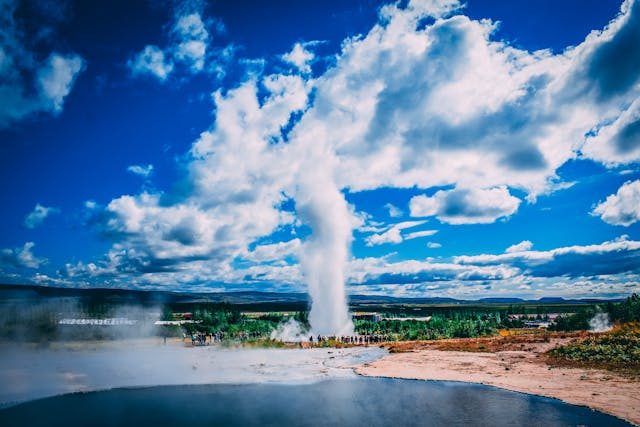
Why do geysers form? Geysers form where the groundwater is heated by geothermal vents until it boils. This steam builds up until the pressure is too great and it erupts out through weak points in the rock.
The word geyser comes from the name of a geyser in Iceland back in 1780. It was called Geysir, which comes from the Old Norse geysa, meaning “to gush”. The geyser was called “the gusher”. Tourists assumed the name was actually the word for a geyser and began to apply it to all geysers.
There are geysers in many countries around the world, but the most famous geyser must be Old Faithful in Yellowstone National Park. It is called Old Faithful because it erupts once every hour, or thereabouts. When it erupts, it shoots roughly 30,000 L of boiling water about 50 m into the sky. It can last from as little as a minute to as long as 5 minutes. The length of time between eruptions has changed over the years, dependent on seismic activity in the area. Old Faithful has been erupting for several hundred years, but geysers can come and go. There will be a day when Old Faithful no longer erupts, or erupts in a slightly different place. Geysers come and go, and today, there are about 1,000 geysers around the world. That will change as the tectonic plates move and the magma gets moved to a new location. Geysers are also disappearing as the underground water disappears as well.
For a geyser to form, you need two things. First, you obviously need a source of water. The water can come from different sources. It can soak through the porous rock or leak down from rivers and seep into spaces in the rock. Where this water comes from doesn’t matter. The second source of water, however, must come from a similar place in all geysers. Every geyser will have something called a plumbing system. This is a network of cracks that lead from the surface all the way down to the deepest source of water. Geysers form in different types of rock, but a volcanic rock called rhyolite is very common. The minerals in this rock are able to keep water inside the plumbing system even under tremendous pressure, which is important, as we will see. The geyser doesn’t just need water; it needs a constantly replenished source of water. If the water is not replenished, then there would be one eruption, and that would be it.
The second thing you need for a geyser to form is heat. The water in geysers is heated by geothermal energy deep under the ground. Magma is several km under the ground, but the water doesn’t have to touch the magma to be heated. The heat will travel up through the layers of rock above the magma and heat the water. Because of this, geysers only form in areas where the magma is closer to the surface, which are places that have a lot of seismic activity. You often find geysers in places that have a lot of volcanoes.
So, what happens? The water at the bottom of the plumbing system is heated by the magma below the rock. The thermal energy is transferred to the water, and it starts to boil. If that was it, we wouldn’t get the explosive power of the geyser. The rest of the plumbing system, all the way up to the top, must also be full of water. The weight of this water presses down on the water below it and that increases the pressure. Just like the pressure increases with depth in the sea, the same thing happens in the plumbing system. Because the pressure is so high, the boiling temperature starts to go up. The water at the bottom reaches 100℃, but the pressure is too high and it doesn’t boil. The temperature continues to rise. Probes dropped into Old Faithful registered temperatures of 118℃, which is almost as high as the temperature you get in a pressure cooker. As the temperature gets higher, more air bubbles form, and the water starts to expand. This expansion pushes a little of the water out of the mouth of the plumbing system, and that makes the pressure drop. The lower pressure lowers the boiling temperature, but the water is already way above that new boiling temperature. The water instantly flashes into steam. Steam takes up 1,500 times more volume than water, and this rapid expansion pushes all of the water and steam out of the plumbing system, creating the geyser. Once the steam has been cleared, water starts to trickle back into the plumbing system, and the whole process repeats itself. And this is what I learned today.
Sources
https://science.howstuffworks.com/environmental/earth/geophysics/geyser.htm
https://www.usgs.gov/news/featured-story/complex-dynamics-geyser-eruptions
https://en.wikipedia.org/wiki/Geyser
https://en.wikipedia.org/wiki/Old_Faithful
https://www.nps.gov/features/yell/tours/fountainpaint/geyser_works.htm
https://www.etymonline.com/word/geyser
https://en.wikipedia.org/wiki/Geysir
Photo by Rudy Kirchner: https://www.pexels.com/photo/geiser-831081/
